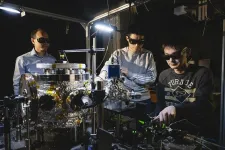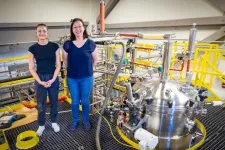(Press-News.org) Nitrogenases are among the most geochemically important enzymes on Earth, providing all forms of life with bioavailable nitrogen in the form of ammonia (NH3). Some nitrogenases can also directly convert CO2 into hydrocarbon chains, making them an exciting target for the development of biotechnological processes. A team of researchers in Marburg, Germany, led by Max Planck scientist Johannes Rebelein, has now provided a comprehensive insight into the substrate specificity and preferences of nitrogenase. Their results challenge the current understanding of nitrogenases and highlight their potential for sustainable bioproduction.
Nitrogen is one of the main building blocks of our cells. However, most of the nitrogen on Earth occurs as gaseous N2 and is chemically unusable by cells. Only a single family of enzymes is able to convert N2 into the bioavailable form of ammonia (NH3): nitrogenases.
Researchers led by Johannes Rebelein from the Max Planck Institute for Terrestrial Microbiology in Marburg have recently discovered that some nitrogenases can also deal with another important substrate: They reduce the greenhouse gas CO2 to hydrocarbons (methane, ethylene, ethane) and formic acid. All these productas are potential energy sources and industrially important chemicals. With a view to sustainable, carbon-neutral bioproduction, the team wanted to know: How well can the enzymes discriminate between CO2 and N2? And do microorganisms that grow on N2 also reduce CO2 under normal, physiological conditions?
Two isoenzymes
To answer these questions, the researchers focused on the photosynthetic bacterium Rhodobacter capsulatus, which harbors two isoenzymes: the molybdenum (Mo) nitrogenase and the iron (Fe) nitrogenase, which the bacterium needs as a reserve in the event of molybdenum deficiency. The researchers isolated both nitrogenases and compared their CO2 reduction using biochemical tests. They found that the Fe nitrogenase actually reduces CO2 three times more efficiently than its molybdenum containing counterpart and produces formic acid and methane at atmospheric CO2 concentrations.
When both enzymes were offered CO2 and N2 at the same time, another important difference became apparent: while Mo-nitrogenase selectively reduces N2, Fe-nitrogenase tends to choose CO2 as a substrate. "Normally, a higher reaction speed in enzymes comes at the expense of accuracy. Interestingly, Mo-nitrogenase is both faster and more selective, showing its advantage in N2 reduction. The lower specificity of Fe nitrogenase and its preference for CO2 make it a promising starting point for the development of novel CO2 reductases," says Frederik Schmidt, PhD student in Johannes Rebelein's lab and co-author of the study.
Wide-spread CO2 reduction in nature?
The low selectivity was not the only surprise. "We analyzed which fraction of electrons ended up in which product and found that methane and high concentrations of formic acid derived from CO2 conversion by Fe nitrogenase were secreted by the bacteria even when no additional CO2 was added to the culture: the metabolically derived CO2 was sufficient to drive this process. This finding suggests that Fe nitrogenase-catalyzed CO2 reduction may indeed be widespread in nature," says Niels Oehlmann, co-first author of the study. This also means that the availability and exchange of one-carbon substrates is likely to influence microbial communities in different environments.
The work challenges the traditional view of nitrogenases as true nitrogen-converting enzymes. Photosynthetic bacteria such as R. capsulatus, which use light energy to stimulate nitrogenases to convert the greenhouse gas CO2, could play a key role not only in their environmental impact, but also in the societal shift towards a sustainable circular economy, says Johannes Rebelein. "The idea is that we can store the energy from the sunlight captured by the microorganism's photosynthetic apparatus in the hydrocarbons produced by nitrogenase. In the future, we want to further develop the iron nitrogenase in order to use it for CO2 fixation and utilization.
END
A taste for carbon dioxide
The remarkable affinity of the microbial enzyme iron nitrogenase for the greenhouse gas CO2 makes it useful for future biotechnologie
2024-08-14
ELSE PRESS RELEASES FROM THIS DATE:
US companies' global market reach linked to cloud computing use
2024-08-14
UNIVERSITY PARK, Pa. — U.S. firms that use cloud computing services are more likely to export their products and services, according to a new study by researchers at Penn State and the U.S. National Science Foundation (NSF). The team said the findings were stronger for firms located outside of large cities and demonstrate the need for expanded availability of the high-speed internet required for cloud computing to support economic development.
The study, which also found that cloud-using firms exported goods and services even more than exporting firms ...
Lake Erie walleye growth is driven by parents’ size, experience
2024-08-14
COLUMBUS, Ohio – Parent size and the conditions in which actively spawning adults lived are the most influential factors affecting growth of Lake Erie walleye, a new study has found.
The findings surprised the scientists, who expected recent temperatures and food availability to have the highest impact on walleye growth.
Cold winters and more sizable mothers were associated with faster growth in 3- to 5-year-old walleye offspring, the analysis showed, suggesting that warmer winters that come with ...
Texas Tech University joins US DOE’s $44 million carbon storage project
2024-08-14
The U.S. Department of Energy’s (DOE’s) Office of Fossil Energy and Carbon Management (FECM) has selected Texas Tech University as one of nine university and industry-led projects to split $44.5 million in federal funding to advance commercial-scale carbon capture, transport and storage across the U.S.
With an award just over $6.2 million, Texas Tech intends to implement and accelerate the equitable and environmentally responsible deployment of storage-based carbon management projects in the Permian Basin. The team will provide technical and engagement support for stakeholders to develop a framework ...
New study reveals loophole in digital wallet security—even if rightful cardholder doesn’t use a digital wallet
2024-08-14
Digital wallets — like Apple Pay, Google Pay and PayPal — are projected to be used by more than 5.3 billion people by 2026. While these wallets promote increased security over traditional payment methods, reliance on outdated authentication methods and prioritizing convenience over security leaves digital wallets vulnerable, according to new research led by computer engineers at the University of Massachusetts Amherst.
“What we have discovered is [that] these digital wallets are not secure,” says Taqi Raza, assistant professor of electrical and computer engineering and an author on the paper. “The main reason is that they have unconditional trust between ...
Researchers discover new way inflammation impacts cell communication
2024-08-14
INDIANAPOLIS – Indiana University School of Medicine researchers have made significant progress in understanding how cells communicate during inflammation. The study, recently published in PNAS, was conducted over a period of five years and focused on the molecules that enable cells to function during inflammation, particularly in the central nervous system where diseases like multiple sclerosis occur.
“Communication is key in any relationship, even at the level of cells that cause disease,” said Mark Kaplan, PhD, chair of the Department of Microbiology and Immunology at the IU ...
Purdue physicists throw world’s smallest disco party
2024-08-14
Physicists at Purdue are throwing the world’s smallest disco party. The disco ball itself is a fluorescent nanodiamond, which they have levitated and spun at incredibly high speeds. The fluorescent diamond emits and scatters multicolor lights in different directions as it rotates. The party continues as they study the effects of fast rotation on the spin qubits within their system and are able to observe the Berry phase. The team, led by Tongcang Li, professor of Physics and Astronomy and Electrical and Computer Engineering at Purdue University, published their results ...
Tropical Atlantic mixing rewrites climate pattern rules
2024-08-14
The churning of the upper ocean in the tropics of Atlantic Ocean plays a crucial role in shaping long-term climate patterns across the world, a new study has found.
Researchers have discovered that changes in the ocean's mixed layer - the topmost section where wind and waves blend warm surface waters with cooler depths - are the primary force behind a climate phenomenon known as Atlantic Multidecadal Variability (AMV) in the tropics.
The AMV has far-reaching effects on global climate. It influences weather patterns from North America to Europe and Africa, affecting everything from hurricane ...
New open access journal from APS and Sage expands publishing opportunity for psychological scientists
2024-08-14
The Association for Psychological Science (APS) and Sage announce the launch of Advances in Psychological Science Open, a fully open access journal that will publish high-quality empirical, technical, theoretical, and review articles, across the full range of areas and topics in psychological science. The journal will accept submissions in a variety of formats, including long-form articles and short reports, and APS is encouraging scientists to submit integrative and interdisciplinary research articles.
“APS is always working to identify new ways to catalyze advances in psychological science,” said APS CEO Robert Gropp. “We are excited to announce ...
iFAB Tech Hub grows net-zero industrial chemical partnerships, champions bioeconomy
2024-08-14
In the wake of the $51 million funding announcement from the Economic Development Administration, momentum is tangible for the Illinois Fermentation and Agriculture Biomanufacturing (iFAB) Tech Hub. Today marks the beginning of a new collaboration to replace fossil fuel-derived petrochemicals with zero-emission alternatives produced through precision fermentation.
Industrial Microbes (iMicrobes) is partnering with the iFAB Tech Hub’s Integrated Bioprocessing Research Laboratory at the University of Illinois Urbana-Champaign to harness microbes to produce acrylic acid, a versatile chemical ...
Fracking frenzy in India: A water crisis in the making?
2024-08-14
India's plans to scale up fracking operations without robust regulations could spell disaster for the country's finely balanced water security, according to research from the University of Surrey.
India is positioning shale gas as a key transitional energy source and has announced 56 fracking projects across six states. Despite the promise of energy independence, Surrey’s study raises alarm bells about the country's preparedness to handle the unique water risks posed by fracking.
Hydraulic fracturing, or fracking, involves injecting high-pressure fluid into shale ...
LAST 30 PRESS RELEASES:
Ancient teeth are treasure troves of data on Iron Age lifestyles
Avocados may become easier to grow in India—but not if global emissions remain high
Pregnant women with IBD show heightened inflammation in vaginal mucosa
Underwater photos show seabirds, seals and fish interacting with a tidal turbine in Washington State
1 in 5 surveyed UK adults who have experienced the death of a pet report it as more distressing than experienced human deaths, with significant rates of prolonged grief disorder symptoms also being re
Polyester microfibers in soil negatively impact the development of cherry tomato plants in experiments, raising concerns over the potential effect of high levels of such contaminants
LGBTQ+ adults may be around twice as likely to be unemployed or to report workforce non-participation compared to heterosexual adults, per large representative Australian survey
Horses can smell fear: In experiments where horses smelled sweat from scared humans, they reacted to scary and sudden events with increased fear and reduced human interaction
New synaptic formation in adolescence challenges conventional views of brain development
Scientists identify target to treat devastating brain disease
Oliver Zielinski selected as Fellow of The Oceanography Society
Has progress stalled on gender equality at work?
Quantum simulator sheds light on how nature moves energy in systems like photosynthesis and solar conversion
Can a hashtag help prevent atrocities? Study shows social media can be a powerful tool
The American Ornithological Society (AOS) announces the winner of the 2025 Wesley Lanyon Award
Woolly rhino genome recovered from Ice Age wolf stomach
An earthquake on a chip: New tech could make smartphones smaller, faster
New research shows how AI tools are expanding individual capabilities while contracting scientific attention
A nanomaterial flex — MXene electrodes help OLED display technology shine, while bending and stretching
Global research team uncovers mechanism by which metabolites guide cellular decisions
Work hours, stress, and burnout among resident physicians
Quality of life of parents of premature infants
Should younger and older people receive different treatments for the same infection?
Scientists discover how fast the world’s deltas are sinking
Scientists demonstrate first-time use of AI for genetic circuit design
Copenhagen researchers make the front page of Nature: Solving the mystery of the universe's ‘little red dots’
Seoul National University-Drexel University team achieves world's highest efficiency fully stretchable OLEDs with 17% external quantum efficiency
Hydrogel cilia set new standard in microrobotics
Application of orthogonal CNOP-I in a convection-allowing ensemble prediction system based on CMA-MESO for improving extreme precipitation skill
Study suggests bamboo has ‘superfood’ potential
[Press-News.org] A taste for carbon dioxideThe remarkable affinity of the microbial enzyme iron nitrogenase for the greenhouse gas CO2 makes it useful for future biotechnologie



